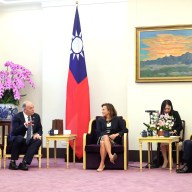KANDAHAR, Afghanistan – The Canadian military says its new methods are effectively weakening the insurgency in Afghanistan, but the Taliban’s resilience is raising questions about the changing nature of the guerrilla war.
Hundreds of fighting-age Afghans have been offered wages to work on development projects, sparing them from having to earn a living by fighting for the Taliban.
It’s one of the counter-insurgency moves used under Brig.-Gen. Jonathan Vance, who will complete his tour of duty as top commander of the Canadian Forces in Afghanistan on Thursday.
Combined with increased Canadian presence in key villages in Dand district, senior military officials suggest the insurgency in the area is beginning to fragment.
“It’s early days, but I would like to posit we’re seeing a definite split with some of the initiatives we’re taking,” said Col. Mike Patrick, the outgoing chief of operations for Canada’s Task Force Kandahar.
He’s referring to the breaking away of Afghans “who would pick up arms and fight with the Taliban to gain money, (who) aren’t necessarily ideologically motivated but are trying to seek a methodology for feeding their family.”
Their departure means that “for the Taliban, the pool for recruiting people has virtually dried up,” Patrick said.
The insurgency now appears to be headed by commanders based in Pakistan – known as the Quetta shura after the city where Taliban leader Mullah Omar is said to be hiding – leaving local, part-time Taliban fighters vulnerable to being influenced by the Canadians.
But even so, the Taliban threat is showing few signs of waning, especially in traditional strongholds.
While Canadians have secured large areas of Dand district, for example, Panjwaii district remains volatile and was the site of the deaths of two Canadian soldiers last month.
One possibility is that there are fewer soft-Taliban than expected – and they have now quit the fight and what’s left is a devoted core.
A tell-tale sign is Kandahar’s reconciliation program, which offers participants amnesty and material incentives in exchange for dropping out of the insurgency.
There are fewer Taliban in the program now than at any point of the last three years. In the first year of the program, 314 Taliban members joined, while only 89 have signed up so far this year, according to figures seen by The Canadian Press.
“In the early days of the Taliban insurgency, the vast majority were paid,” said Thomas Johnson, a professor at the U.S. Naval Postgraduate School who has advised American generals as well as Vance on the Afghan insurgency.
“That is not the case anymore. The Taliban are not paying foot soldiers anything. Afghans are not joining for monetary reasons, but for ideological reasons.”
Another element is the presence of foreign fighters. Militants from Chechnya have long been a factor in Kandahar but are now being joined by jihadists from Iraq.
A former Taliban member has told a researcher that despite well-publicized differences, membership in the Afghan Taliban and the Pakistani Taliban is often interchangeable.
“There is no difference between the Taliban of Afghanistan and Pakistan,” said Mulla Muhammad Zahir. “They come here for jihad and Afghans go there for jihad.”
However, Haji Agha Lalai, a prominent Panjwaii district elder who until recently ran Kandahar’s branch of the National Reconciliation program, said Pakistani fighters are considered better skilled than their Afghan counterparts and are a valuable commodity for the insurgency.
“The Pakistani Taliban teach the Afghan Taliban how to fight,” he said. “They are technologically superior.”
Senior military officers have said they welcome the Pakistan government’s recent offensive on Taliban militants in South Waziristan and are quietly hoping the push continues into Baluchistan, which borders Kandahar province and is where the Afghan Taliban most often seek refuge.
This raises the question of whether Canadians are dealing with an indigenous or foreign-led insurgency.
“The fact of the matter is that it doesn’t really matter,” said Patrick. “If you’ve got an ideology that’s rooted in a group a and it’s spread across a border. The border issue needs to be dealt with.”
However, an indigenous insurgency suggests a political solution may be possible for the Afghan government, whereas good governance would be only a small factor in an international movement.
Canadian military officials highlight the Taliban’s violence and intimidation of the populations under its control. But some Afghans say Taliban governance has grown in popularity in certain rural areas.
“If the situation continues, there will be more and more people seeking to wage jihad,” Lalai said. “The Taliban are trying to give people the sense that being a Talib equals true citizenship.”
In the eyes of many analysts, the rural areas form the heart of the insurgency. But the model-village approach is aimed at protecting access to Kandahar city, which one Canadian officer referred to as the “castle of the hill.”
“There is occasionally attention paid to urban areas,” said Johnson. “But this is basically an information campaign, a way of saying we can operate anywhere, anytime, to suggest no one is secure.”















